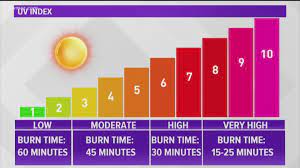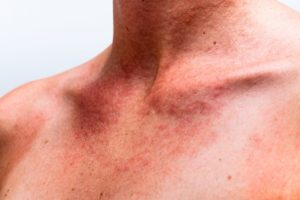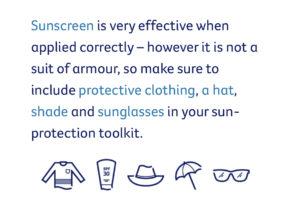Most Australians will only use sun protection on the hottest days of summer and forget it is not heat but UV rays that cause sunburn and photoageing as well as skin cancer.
Australia has among the highest rates of skin cancer in the world and it is possible to burn in as little as 11 minutes on a summer's day.
Ultraviolet (UV) radiation, unlike Infrared heat, is invisible and around us anytime there is daylight. It is radiation we can neither see nor feel and is present on even overcast and cool days in winter, as well as on cloudy days.
Exposure to UV radiation is the major contributing cause of photo ageing, sun damage and skin cancer, so at Skin Essentials, at an initial consultation with any new patient, we cover sun protection in depth, because it is our firm belief that it forms the basis of all anti-aging practices, without which all other in-clinic treatments will give subpar results.
What types of UV are there?
UVA - tends to penetrate deeper into the skin's layer, the dermis, where it can trigger the pigment producing cells, the melanocytes, causing tanning. Darkening of the skin is always a sign of sun damage. It is also associated with cell damage and skin cancers.
UVB- tends to penetrate skin more superficially, the epidermis and is more likely to cause sunburn; Ozone stops most of the UVB from reaching us but 15% of it still gets through.
UVC - the most dangerous type but the Ozone layer absorbs all of it and none of it reaches us.
On any given day, year around, UV levels vary and are affected by location, altitude, time of day, time of year and clear vs cloudy skies. UV rays are present all year around anytime there is daylight.
The UV Index
 The UV index is a tool to enable you to protect yourself from UV radiation. It tells us the times of the day when UV is expected to be highest so that we need extra protection.
The UV index is a tool to enable you to protect yourself from UV radiation. It tells us the times of the day when UV is expected to be highest so that we need extra protection.
Sun protection measures are recommended anytime the UV index is at 3 or above above which it can cause skin damage.
What are some ways we can be exposed to UV rays and not even realise it?
Incidental sun exposure is rife among Australians and it all adds up over a lifetime of sunburn, sun damage and over time, skin cancer risk.
 Examples of incidental sun damage:
Examples of incidental sun damage:
What is SPF?
SPF stands for Sun Protection Factor. It is the amount of time the sunscreen will protect you from the UV rays. SPF on sunscreen tells you how much additional protection you will obtain by using it.
For example, if you are someone who would normally burn after 30 mins of sun exposure, using a sunscreen with an SPF rating of 15 would multiply this protection THEORETICALLY by 15 ie 450 minutes before you burn.
In reality, this is impossible because:
For these reasons, it is recommended we reapply sunscreen regularly:
So how does your SPF protect you from UV rays?
Every bit of UV exposure adds up over the years to photoageing and contributes to your risk of skin cancer
How much sunscreen should you use?
Suncreen is very effective when applied correctly - however it is not a suit of armor so other protective measures are just as important:

| Monday: | By agreement only |
| Tuesday: | CLOSED |
| Wednesday: | 10:00 - 17:00 |
| Thursday: | 10:00 – 18:00 |
| Friday: | 09:00 – 17:00 |
| Saturday: | 09:00 – 15:00 |
Skin Essentials will reopen the week beginning 11th October 2021.
Per NSW government regulations, only double vaccinated patients will be served when we reopen and we will be checking vaccination certificates for all patients upon booking. This requirement may change as of December 1st, and we will advise you accordingly.
Please email us (contact@skinessentials.com.au) or text us (0413174654) your vaccination certificate as soon after booking as you can. We will not be able to see anyone for treatments or confirm appointments without this.
In the interest of full disclosure, transparency and patient safety, all patient facing staff will be fully vaccinated by the time of reopening. Please read our reopening FAQ for more information.